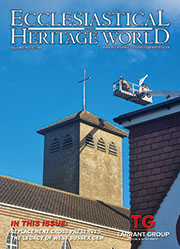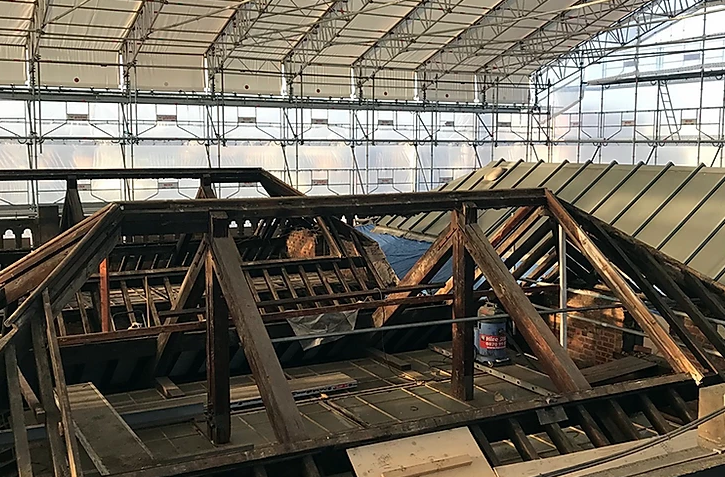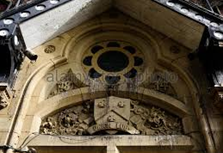Heritage Roofing
Heritage roofing - maintaining our iconic buildings
The UK is home to some of the most iconic buildings in the world, from stunning churches and cathedrals to historic stately homes. Each and every one of these remarkable feats of architecture requires regular maintenance to ensure they remain in the very best condition, allowing them to be enjoyed for generations.
Cathedral Care
Restoration and upkeep of cathedrals
There are some 42 Anglican cathedrals in the UK, not to mention 20 or so Catholic cathedrals. Cathedrals form the most important collection of historic buildings in England. The largest and most ancient are internationally famous, the smallest are usually among the most significant buildings in their region and even the most recent are architectural masterpieces.
Master Craftsmen
Championing our heritage with modern craftsmanship
Twenty years ago, English Heritage (now Historic England) published its first-ever Register of Buildings at Risk across England, which featured nearly 2,000 buildings and monuments that were ‘neglected, broken and unloved’. Recently Historic England was delighted to announce that over two-thirds of those buildings were now safe, in both urban and rural areas right across the country.
Traditional Lime
Lime: it’s better for buildings – and for the environment
It is now fairly well known that cement is not good for old buildings and that lime mortar should be used. But why? What are the advantages and what are the disadvantages? In order to begin to answer those questions it is necessary to understand the nature of traditional building, the process by which buildings used to be built, and how it differs from modern construction, the process by which we build today.
Audio Visual
Audio visual equipment in church buildings
This guidance is issued by the Church Buildings Council under section 55(1)(d) of the Dioceses, Mission and Pastoral Measure 2007. As it is statutory guidance, it must be considered with great care. The standards of good practice set out in the guidance should not be departed from unless the departure is justified by reasons that are spelled out clearly, logically and convincingly.
Read More...
CRE Events
Exhibitors enthuse over the CRE experience
By 4pm on the first day of CRE 24 at the Marshall Arena in Milton Keynes, exhibitors Chris and Kim Dunphy had already had so many helpful and detailed conversations with visitors that they were “completely talked out”.
Insurance
You need to ensure that reasonable precautions are in place at your church to keep it safe for those who use it. To do this, you need to think about what might cause harm to people.
You will then need to decide if the precautions already in place are adequate. If they are not, you may need to identify further action to prevent any danger. When done formally, this is known as a risk assessment.
Church Maintenance
Church maintenance and repair: Calendar of Care
Just as prevention is always better than cure, maintenance is preferable to major repairs. But, such repairs may not always be avoidable. Church Care offers a monthly guide in our coming issues Starting in Spring
We can help you understand the common problems and areas that need your special attention, and give you tips for regular maintenance schemes.
Pest Control
Michael Palin warns of pest threat to churches
Michael Palin is supporting the future of the UK’s historic churches and chapels with a voiceover for a new animated film. The 80 second animation, produced for the National Churches Trust, highlights why churches are some of the nation’s best loved buildings.
Town Halls
The history of the great Victorian Town Halls of Northern England
From industrial squalor to civic pride, the story behind some of the most impressive buildings of the North involve a unique mix of economics, grand designs and noble sentiments within communities.
Lead Roofing
Lead is one of the oldest materials in the roofing industry and is still commonly used throughout the world today.
Lead roofing is a traditional roofing method which has been used in the industry for hundreds of years, and is therefore proven to be extremely reliable. Lead roofing, and sand-cast lead, in particular is ideal for old buildings such as churches or historical renovations, whereas milled lead roofing is a mass-produced alternative, used for precision and accuracy in homes and commercial buildings alike.
Lightning Protection
When lightning strikes are you protected against this act of God?
The issue of lightning protection in churches is one that has exercised this publication for many years. In this four-part series of spotlights on the issue we will be revisiting various aspects of the subject, beginning with an overview of current thinking.
SEARCH OUR DIRECTORY
St Astier
Lime Mortar Render & Plaster from St Astier
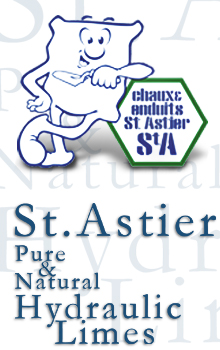
St Astier Natural Hydraulic Limes (NHL) and derivative products have been produced by the same families since 1851. The mineralogical characteristics of the raw materials, the manufacturing process and the quality controls are such that users are assured of the constant performance of the products. The experience acquired over the years is shared with the user through the assistance available from the Technical Department and from carefully chosen specialist distributors, able to assess the type of lime mortar, plaster or render required. This is especially important in Conservation and Restoration, where mortars should be project specific in order to ensure their compatibility with existing materials and the fabric of the buildings.
In new build St.Astier Limes have developed a range of binders and ready mixed mortars combining all the characteristics required by today’s builder in terms of speed of setting, strength, elasticity, plasticity, low capillarity and shrinkage, with the breathability and aesthetic quality of lime mortars. The result is that these lime mortars are becoming the obvious alternative to cement mortars also in the new build and eco build sectors.
The ecological benefits of lime mortars such as CO2 re-absorption and condensation control provide vital answers to some of today’s environmental and energy saving requirements which cannot be ignored by the professions and trades involved in the protection of the built heritage and in the construction of our new living environment.
The purpose of this web site is to provide as much information as possible to the specifier and the user, so that correct choices can be made on scientific and practical bases. This information, together with the quality of the products and the co-operation and technical assistance of the Manufacturer and its distributor network, are the main reasons of the success of St. Astier hydraulic limes worldwide.
St. Astier natural hydraulic limes (NHL) and lime mortars have been adopted in a number of countries and in the most diverse climatic conditions, from the Arctic circle to the desert, from marine locations to high mountain sites.They have been and are used on some of the most important world heritage sites, in vernacular and ordinary buildings, in reproducing the characteristics of ancient mortars as well as providing solutions to modern architectural mortar requirements. The technical expertise at hand will also assist in achieving engineering solutions when an alternative to cement mortars is required.
St. Astier natural hydraulic lime mortars in the construction of the Living Villages eco friendly houses
Eco Build The Living Villages Phase two of the award winning eco village 'The Wintles' nears completion.
The new phase is a cluster of nine houses. Each one is a unique design. Eight are spacious three-story structures with enormous windows and interiors that can be easily adapted to suit specific needs. They also have two story conservatories on the front facade. Together, they advance the Living Villages concept of ecofriendly, energy efficient homes a stage further. They are built to exceptionally high standards of both materials and workmanship. The first phase of the village has won awards for these high standards of eco-friendliness.
Each house has under-floor heating, solar panels, heat recovery systems, high performance triple-glazing, an internal vacuum cleaning system, broadband facility, a car port and private garden. These houses far exceed the new national standards for energy efficiency.
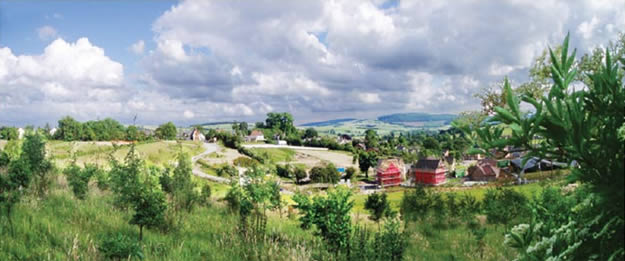
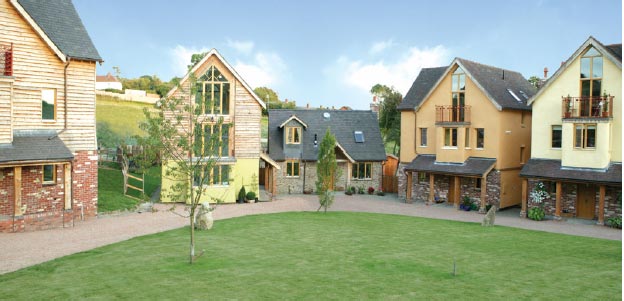
The St. Astier renders and mortars have been chosen for their aesthetic benefits, performance and primarily because of their reduced embodied energy and breathability over conventional cement based mixes.
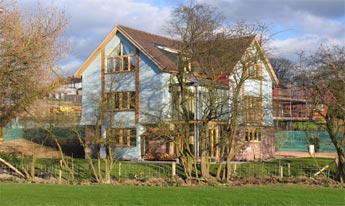 A combination of different lime mortars has been used to coat the rendered elements of the properties, the first coat has been applied on to a metal lathing system, incorporating fibres. Brickwork was built with NHL 5 mortars. The bricks used in cavity walls and garden walls are reclaimed. Renders have used NHL 3.5 for the base coat and NHL 2 for finishing coats. Natural paints, also supplied by Lime Green*, have helped create fantastic colour schemes.
A combination of different lime mortars has been used to coat the rendered elements of the properties, the first coat has been applied on to a metal lathing system, incorporating fibres. Brickwork was built with NHL 5 mortars. The bricks used in cavity walls and garden walls are reclaimed. Renders have used NHL 3.5 for the base coat and NHL 2 for finishing coats. Natural paints, also supplied by Lime Green*, have helped create fantastic colour schemes.
* Lime Green is the St. Astier distributor for the area.

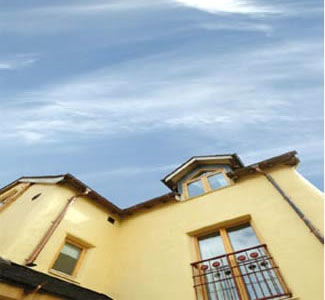
Some houses have stone walls. Also these are built with a St. Astier Natural Hydraulic lime mortar.
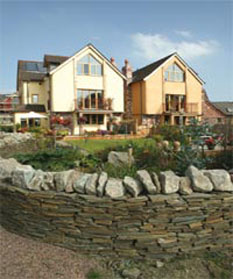
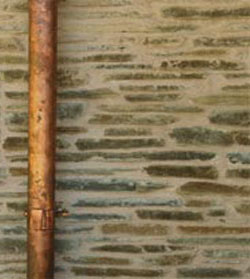
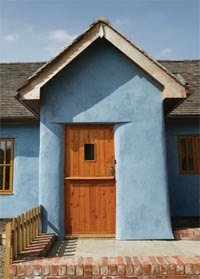
The Lime Centre
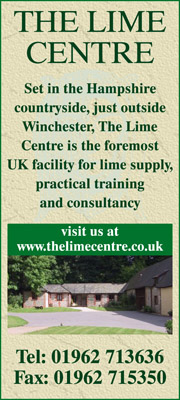
Universally during the past 25 years there has been an increasing awareness of the importance of lime in historic architecture and, in particular, it's use in conservation. A number of authoritative bodies such as English Heritage, the Building Research Establishment, the Society for the Protection of Ancient Buildings and the Standing Joint Committee on Recruitment and Training of Architects for the Care of Old Buildings, have produced and published a great deal of valuable academic work on the subject.
'Building with Lime' by Stafford Holmes and Michael Wingate is an excellent example of the material now available. It has become evident that today's student almost suffers from a surfeit of academic information, but has very little opportunity to gain practical experience. The consensus of opinion was that facilities for 'hands on' experience were needed to complement academic courses already being provided.
The Lime Centre at Morestead, near Winchester, has been created within a group of redundant farm buildings on a three-acre rural site. the main barn was built about 1750 of chalk cob and extended in 1820 in flint and brickwork. A derelict outbuilding adjoining this barn has been converted into a reception area which doubles as a lecture room. There is generous car parking in what was the old farmyard and course director Bob Bennett lives in the recently converted part of the barn.
After holding several experimental courses in 1988 and 1989, an Advisory Panel was formed with Lord Carnarvon KVCO KBE as President. The Centre was opened in May 1990 by the Chairman, John Ashurst. During the first year thirty courses were held; most structured as a basic introduction to lime in traditional building. These, together with advanced courses dealing specifically with lime mortars, plasters, renders, washes and chalk cob, were received enthusiastically by S.P.A.B., English Heritage, the R.I.C.S., The Institute of Advanced Architectural Studies at York University, Bournemouth University and the C.I.T.B.
Materials for sale from The Lime Centre include mature, fine-sieved lime putty, natural hydraulic limes, ready-mixed lime mortars, plasters, renders and washes. Consultancy and a mortar analysis service is also available.
The Lime Centre
Long Barn
Morestead
Winchester
Hampshire
United Kingdom
SO21 1LZ
T: +44 (0)1962 713636
F: +44 (0)1962 715350
Business Hours: 8.30am - 5.00pm weekdays only
This email address is being protected from spambots. You need JavaScript enabled to view it.
http://www.thelimecentre.co.uk/
Lime Firms

"Carbon dioxide emissions; climate change and global warming"
These are words and concepts which will dominate our thinking for the foreseeable future; especially when it comes to our built environment.
How can these issues be addressed in a pragmatic response by builders and designers in their choice of building materials?
Lime Firms’s guiding principle is to consider the carbon dioxide emission burdens of all the materials we sell. It is not always possible to take the most desirable route – but this overarching philosophy helps to keep these crucial issues to the fore.
Services
We can provide :
Site visits
Mortar analysis - petrographic or chemical
Colour matching
Advice on materials choices and quantities
Support to specifiers and designers
Recommendation for appropriate training courses
Lime Firms is committed to helping all those working with buildings – be they DIY’ers, builders, specifiers, designers or architects - to address the challenges presented by old and new buildings. The selection of the right materials and the development of appropriate working practices is a matter of great skill. We take a constructive approach to work with all parties to try to bring about a successful outcome.
Consultancy
There is a wealth of information on the use of the materials offered available in books, manufacturer’s product information and the internet.
Occasionally it is necessary to discuss problems on site. Sometimes it will be necessary to take samples of mortar or limewash, for example, in order to attempt to replicate existing renders or finishes. We are able to visit sites by arrangement and to make suggestions about materials or construction techniques.
When it comes to the use of novel or experimental approaches, on-site advice is often fundamentally important to achieve success.
Courses
Lime Firms Ltd runs courses both at Bridgend College and also at the National Trust's property at Llanerchaeron, near Aberaeron.
Introduction to Lime course
The Introduction to Lime course, recently held at the National Trust property deals with not only lime mortars and their application in the heritage sector, but also the use of lime as a binder in new-build work. The crucial importance of careful aggregate selection, correct mixing and application techniques are just some of the subject areas covered. In addition, consideration is given to some of the novel lime-based construction techniques such as hemp and lime insulating plasters, hemp concrete and lightweight lime concrete.
Participant numbers are limited to no more than 10, in order to maximise the value of the day's attendance.
Lime Firms also runs courses at the Bridgend College as part of the Bridgend Town Heritage Improvement scheme, and has run courses in working with Traditional and Ecological Paints and Finishes as well as with lime.
Please contact Lime Firms to find out more and to book a place on one our forthcoming courses.
Lime Firms
Corgam Farm
Bwlchllan
Nr Lampeter
Ceredigion
SA48 8QR
T: 01974 821 624
This email address is being protected from spambots. You need JavaScript enabled to view it.
http://www.limefirms.co.uk/










